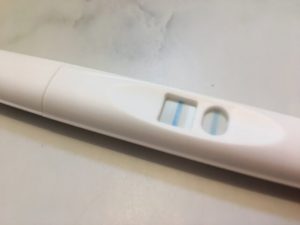When you find out you’re pregnant, you may feel excited about the birth of your child but also have various worries until the delivery. In this article, we introduce the overview of combined prenatal screening and the differences from NIPT (Non-Invasive Prenatal Testing) that can be performed before birth.
What is Combined Screening?

Combined screening, also known as the combined test, is a test that combines two types of tests: ultrasonography and serum marker analysis. It is performed when pregnant women want to know if there are any chromosomal abnormalities in the fetus. Combined screening can be conducted between 11 weeks 0 days and 13 weeks 6 days of pregnancy.
Measurement of NT (Nuchal Translucency) by Ultrasonography
Ultrasonography, also known as fetal ultrasound, measures the swelling that occurs at the back of the baby’s neck. This swelling, known as nuchal translucency (NT), is characteristic of chromosomal abnormalities such as Trisomy 21 (Down syndrome) and Trisomy 18 (Edwards syndrome). If swelling is observed, there is a high possibility of chromosomal disorders such as Trisomy 21 and Trisomy 18.
However, it’s important to note that the presence of swelling at the back of the neck does not always indicate chromosomal abnormalities. Conversely, chromosomal abnormalities can occur even if there is no swelling.
Analysis of Serum Markers by Blood Sampling
In the serum marker test, various hormones and proteins derived from the fetus and placenta in the maternal bloodstream are measured, including AFP (Alpha-fetoprotein), free β-hCG (free beta-human chorionic gonadotropin), Inhibin-A, PAPP-A (Pregnancy-associated plasma protein-A), and Placental Growth Factor (PlGF), among others. The test results are not only based on these absolute values but also take into account factors such as maternal age and gestational age for a comprehensive assessment. The older the mother, the more likely she is to have false positives.
Even if swelling is found at the back of the fetus’s neck through ultrasonography, it does not necessarily mean that a chromosomal abnormality is present. Swelling could be caused by other factors as well. Therefore, it is important to conduct maternal blood tests to make a comprehensive judgment.
In cases of Trisomy 21 (Down syndrome) in the fetus, hCG levels are typically more than double, while PAPP-A levels are approximately half. For Trisomy 18 or Trisomy 13, both hCG and PAPP-A levels are said to be around one-third of the average values for pregnant women.
Analysis by Combining Ultrasonography and Serum Markers
Combined screening is a test conducted in the early stages of pregnancy, combining the aforementioned ultrasonography and serum marker analysis. It aims to detect chromosomal abnormalities in the fetus. By combining these two tests, the likelihood of detecting chromosomal disorders is increased.
How to Confirm the Results of Combined Screening
The results of combined screening are presented as probabilities, often in the form of ratios such as 1:XX (a number). The numerical value of the probability varies depending on the type of chromosomal disorder. For example, for Trisomy 21, a probability higher than 1:220 is considered high risk, while for Trisomy 18, a probability higher than 1:100 is considered high risk.
However, it’s important to note that combined screening indicates whether the risk is high or low and does not definitively diagnose chromosomal abnormalities in the fetus. Therefore, even if the screening shows a high risk, there is still a possibility that the fetus does not have chromosomal abnormalities. If indicated as high risk, it’s recommended to undergo a more accurate test like NIPT (Non-Invasive Prenatal Testing).
Diseases Covered by Combined Screening
Combined screening can assess the risk of chromosomal disorders in the fetus, specifically focusing on three conditions: Trisomy 21, Trisomy 18, and Trisomy 13.
Trisomy 21, commonly known as Down syndrome, occurs when there is an extra copy of chromosome 21. Symptoms include developmental and intellectual delays.
Trisomy 18, also known as Edwards syndrome, is caused by an abnormality in chromosome 18. It is characterized by intellectual disabilities and physical abnormalities.
Trisomy 13, known as Patau syndrome, is caused by an abnormality in chromosome 13. Like the other chromosomal disorders, it presents with severe intellectual disabilities and physical abnormalities.
Postnatal Hair Loss Prevention
Here, we’ll introduce five benefits of undergoing combined screening. By understanding the features and advantages of combined screening, you can check which tests to consider when you become pregnant.
Less Burden on Pregnant Women and Babies
Combined screening is conducted through ultrasonography and blood sampling, which means it imposes less burden on pregnant women and fetuses. Amniocentesis, on the other hand, is believed to cause some discomfort to pregnant women as it involves stimulating the abdomen. Since combined screening imposes minimal burden on both pregnant women and babies, it is recommended for those who want to minimize the impact on the fetus.
Lower Cost Compared to Other Tests
One of the distinctive features of combined screening is its relatively low cost compared to other prenatal diagnostic tests. The exact cost may vary depending on the healthcare facility, but generally, combined screening can be conducted for approximately 30,000 to 50,000 yen. Therefore, if you want to keep the expenses down while undergoing the test, combined screening is recommended.
Higher Accuracy than Ultrasonography Alone
One of the advantages of combined screening is its high accuracy. By combining ultrasonography with serum marker analysis, it has a higher likelihood of detecting chromosomal abnormalities compared to individual tests. While it is not a definitive diagnostic test, it is effective in detecting abnormalities at an early stage and providing valuable information for determining whether further testing is necessary.
Ability to Check for Baby’s Morphological Changes
In combined screening, ultrasonography is conducted slowly and carefully, allowing for observation of fetal morphological changes. Therefore, it is recommended for those who want to undergo the examination while monitoring the growth of the fetus.
Testing Available in Early Pregnancy
Combined screening can be undergone in the early stages of pregnancy. When pregnant, many mothers may have various anxieties about whether the fetus is developing healthily. Knowing early on whether the baby has any abnormalities is an important factor in reassuring mothers and ensuring a smooth process until childbirth. Therefore, combined screening, which can be performed in the early stages of pregnancy around 11 weeks 0 days to 13 weeks 6 days, plays a crucial role in providing both information about chromosomal abnormalities and peace of mind to expectant mothers.
Differences from NIPT (Non-Invasive Prenatal Testing)
There are other tests besides combined screening to examine fetal chromosomal abnormalities, such as Non-Invasive Prenatal Testing (NIPT). NIPT involves testing blood components collected from the mother to confirm whether the fetus has chromosomal abnormalities. Here, I’ll introduce the differences between these two tests.
Higher Accuracy in NIPT
NIPT testing has a sensitivity of over 99% for Trisomy 21 and Trisomy 18, meaning that if there is a chromosomal abnormality in the fetus, it will be detected with a probability of over 99%. Additionally, even for Trisomy 13, the sensitivity is relatively high at 91%. The negative predictive value of NIPT testing is said to be over 99.9%, meaning that if the result is negative, it’s highly unlikely that the three chromosomal disorders—Trisomy 21, Trisomy 18, and Trisomy 13—are present.
NIPT Can Be Done Earlier
NIPT testing allows for earlier testing compared to combined screening. While combined screening is typically conducted between 11 weeks 0 days and 13 weeks 6 days of pregnancy, NIPT testing can be performed around 10 to 18 weeks of pregnancy. In recent times, testing has been possible even before 10 weeks. Given the various anxieties that arise concerning the health of the fetus during pregnancy, those who wish to detect abnormalities as early as possible may find NIPT testing preferable.
Different Congenital Abnormalities Covered
Generally, NIPT testing targets three congenital abnormalities: Trisomy 21, Trisomy 18, and Trisomy 13. While combined screening also allows for screening of these three chromosomal abnormalities, the difference lies in the ability to confirm the fetal body structure through ultrasonography.
NIPT Provides Positive/Negative Results, While Combined Screening Provides Probability
In NIPT testing, chromosomal abnormalities in the fetus are determined as positive or negative by collecting blood from the mother during pregnancy. This method of testing imposes minimal burden on both the mother and the fetus, with little to no pain or risk involved. Combined screening tends to have a lower detection rate for chromosomal abnormalities compared to NIPT testing. The results of the test are presented in terms of probability. However, there is a benefit of being able to undergo the test at a lower cost. Since neither test provides a definitive diagnosis, it is important to conduct further diagnostic testing if the risk of chromosomal abnormalities is identified.
Conclusion
Combined screening is a method of testing that allows for the confirmation of whether the fetus has chromosomal abnormalities from the early stages of pregnancy. Since it is not a definitive test, if the result indicates a high risk, it is recommended to undergo confirmatory testing. Additionally, for those who wish to undergo a highly accurate test at an early stage, it is worth considering undergoing NIPT (Non-Invasive Prenatal Testing).
【References】
- Prenatal Testing That Can Be Performed at 11-13 Weeks of Pregnancy, What Is Combined Screening? | NIPT Reservation Center
- What Is Combined Screening? Differences from Other Tests | DNA Advanced Medical Corporation
- Genetic Ultrasound Marker Testing・Combined Screening | Pre-Natal Testing Accreditation Committee
- What Is Combined Screening? | GeneTech Corporation
- Differences Between Non-Invasive Prenatal Testing (NIPT) and Fetal Doppler? Which One Should You Choose If You’re Unsure? | NIPT Reservation Center
Q&A
-
QWhen will the results of the combined screening be available?The results of the combined screening will be reported in approximately two weeks. As the time it takes to receive the results varies slightly from one medical centre to another, it is advisable to enquire in advance with the medical centre where you want to have the test carried out.
-
QIs combined screening definitive?Combined screening is a non-probative test. The risk of chromosomal abnormalities is expressed as a probability. Therefore, a high probability does not always mean that an abnormality will be detected. If you want a definitive result, you need to undergo a definitive test such as a trophoblastic test or an amniotic fluid test. Many pregnant women use the combined screening as a decision-making tool for a definitive test.
-
QWhat should I do if the probability is high in a combined screening?Combined screening, as mentioned earlier, is a nonconclusive test and is performed to confirm risk. If the test results indicate a high risk and you want a definitive diagnosis, you should undergo a definitive test, such as a trophoblastic test or amniotic fluid test. It is important to discuss with the couple and also with the health care provider in advance what tests they will undergo.
Article Editorial Supervisor

Dr Hiroshi Oka
NIPT specialist clinic, MD
Graduated from Keio University, School of Medicine
 中文
中文






















